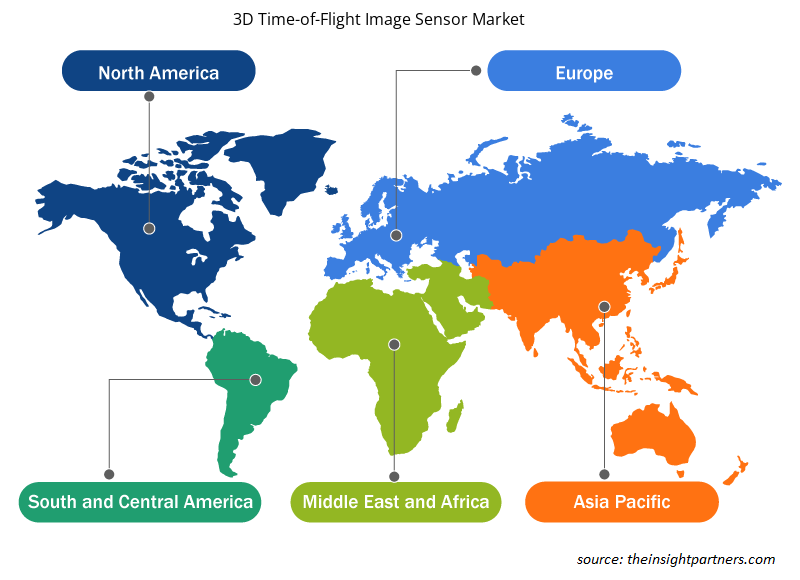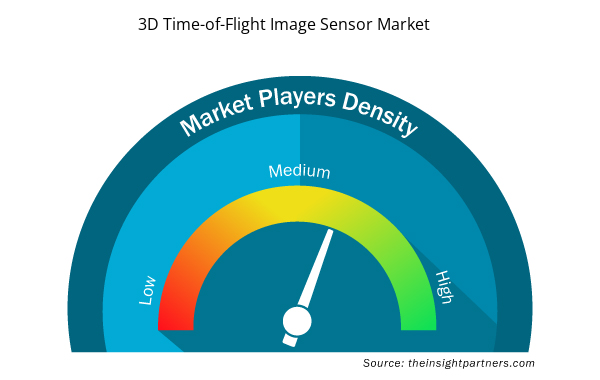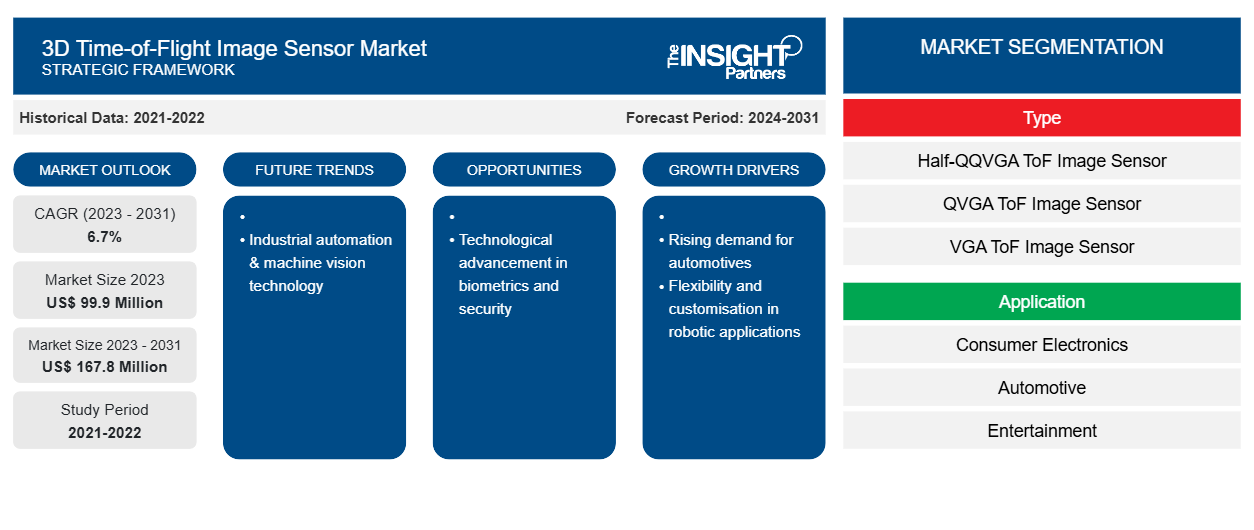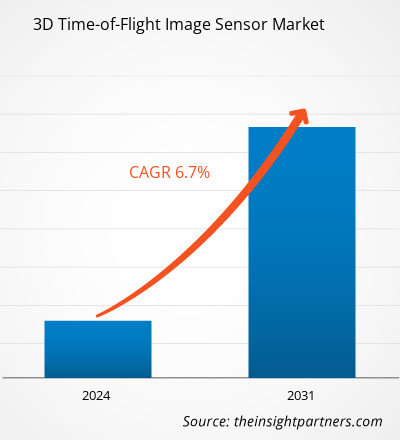Der Markt für 3D-Time-of-Flight-Bildsensoren soll von 99,9 Millionen US-Dollar im Jahr 2023 auf 167,8 Millionen US-Dollar im Jahr 2031 anwachsen. Der Markt soll zwischen 2023 und 2031 eine durchschnittliche jährliche Wachstumsrate (CAGR) von 6,70 % verzeichnen. Die wachsende Nachfrage nach Unterhaltungselektronik sowie Flexibilität und Anpassung bei Roboteranwendungen dürften weiterhin die wichtigsten globalen Trends auf dem Markt für 3D-Time-of-Flight-Bildsensoren bleiben.
Globale Marktanalyse für 3D-Time-of-Flight-Bildsensoren
TOF-Systeme für die Innenraumerfassung bieten im Allgemeinen eine Distanzgenauigkeit von 1 % (entspricht 1 cm) innerhalb eines Meterbereichs bei Verwendung eines einzelnen VCSEL. Die Verwendung von Time-of-Flight-Sensoren (TOF) in Roboteranwendungen bietet zahlreiche Vorteile. Diese Sensoren liefern im Allgemeinen genauere Tiefenmessungen als 2D-Kamera-Videostreams, die durch Bildanalyse verarbeitet werden. Darüber hinaus sind TOF-Kameras für ihr Fehlen beweglicher Komponenten, ihren kompakten Formfaktor und ihre kostengünstige Produktion bekannt. Sie sind besonders wertvoll für Echtzeitanwendungen und liefern außergewöhnlich präzise Tiefendaten bei Geschwindigkeiten von bis zu 60 Bildern pro Sekunde.
Globaler Marktüberblick über 3D-Time-of-Flight-Bildsensoren
Die 3D-Time-of-Flight-Bildsensortechnologie (TOF) ist ein revolutionärer Fortschritt in der Bildverarbeitungsbranche. Durch die Verwendung eines kostengünstigen CMOS-Pixelarrays zusammen mit einer aktiv modulierten Lichtquelle ermöglicht diese Technologie 3D-Bildgebung. Sie funktioniert, indem sie die Zeit misst, die Lichtimpulse benötigen, um eine Distanz durch ein Medium zurückzulegen. Diese bahnbrechende Innovation ermöglicht die Echtzeiterfassung einer echten 3D-Tiefenkarte der physischen Welt. Sie wandelt die Szene, die Umgebung und alle Objekte im aufgenommenen Bild effektiv in den digitalen Raum um. Die integrierten Algorithmen des Sensors werden dann verwendet, um die relative Entfernung zwischen jedem Objekt und der Lichtquelle sowie die Abmessungen der Objekte zu messen.
Passen Sie diesen Bericht Ihren Anforderungen an
Sie erhalten kostenlose Anpassungen an jedem Bericht, einschließlich Teilen dieses Berichts oder einer Analyse auf Länderebene, eines Excel-Datenpakets sowie tolle Angebote und Rabatte für Start-ups und Universitäten.
- Holen Sie sich die wichtigsten Markttrends aus diesem Bericht.Dieses KOSTENLOSE Beispiel umfasst eine Datenanalyse von Markttrends bis hin zu Schätzungen und Prognosen.
Treiber und Chancen auf dem globalen Markt für 3D-Time-of-Flight-Bildsensoren
Die zunehmende Konvergenz von Unterhaltungselektronik in der Automobilindustrie und die wachsenden Anforderungen autonomer Fahrzeuge
Der Automobilsektor hat erhebliche Veränderungen erfahren, um das Fahrerlebnis zu verbessern. Die heutigen Fahrzeuge werden intelligenter, können sich selbst diagnostizieren und kommunizieren besser mit anderen Fahrzeugen auf der Straße. Trends wie Advanced Driver Assistant Systems (ADAS), Infotainmentsysteme und Fahrzeugtelematik haben in der Automobilindustrie an Bedeutung gewonnen. Diese Fortschritte sind größtenteils auf die Raffinesse und den technologischen Fortschritt in der Halbleiterindustrie zurückzuführen. Darüber hinaus hat die Implementierung von Sicherheitsfunktionen im letzten Jahrzehnt zu einem Rückgang der Autounfälle und Todesfälle geführt. Dank der zunehmenden elektronischen Integration verfügen Fahrzeuge heute über eine größere Rechenleistung. Die Entstehung von Trends wie Fahrzeugtelematik und benutzerfreundlichen Infotainmentsystemen wird mit einem Schwerpunkt auf die Sicherheit von Fahrer und Passagieren entwickelt. Diese Systeme ermöglichen auch die Erkennung von Hindernissen, die Navigation und eine verbesserte Bedienung des Infotainmentsystems in den Fahrzeugen. Darüber hinaus ermöglicht die Integration von 3D-ToF-Sensoren in Automobilanwendungen eine fortschrittliche, benutzerfreundliche und bequeme Bedienung des Infotainmentsystems, einschließlich einfacher Handwischbewegungen für Aufgaben wie das Wechseln von Musik- oder Radiokanälen während der Fahrt. Infolge dieser Fortschritte wird erwartet, dass die Nachfrage nach 3D-Time-of-Flight-Sensoren im Automobilmarkt im Prognosezeitraum steigen wird.
Technologische Entwicklung in Biometrie und Sicherheit
Der rasante technologische Fortschritt in Biometrie und Sicherheit wird voraussichtlich in naher Zukunft einen erheblichen Einfluss auf den Bedarf an 3D-Time-of-Flight-Bildsensoren haben. Dieser Fortschritt wird von verschiedenen Faktoren beeinflusst, wie etwa Fortschritten in der Biometrietechnologie , zunehmender Akzeptanz in der Öffentlichkeit und der steigenden Nachfrage nach verstärkten Sicherheitsmaßnahmen. Der rasante technologische Fortschritt in Biometrie und Sicherheit wird durch Fortschritte in der Biometrietechnologie vorangetrieben, die die Einführung biometrischer Systeme beschleunigen. Neuere Systeme integrieren beispielsweise künstliche Intelligenzanalysen, um 3D-Bilder von gefälschten flachen Bildern zu unterscheiden, wodurch Einschränkungen der biometrischen Sicherheit behoben und Hindernisse für die Einführung abgebaut werden. Die biometrische Technologie nutzt messbare biologische Merkmale, um die digitale Benutzeridentität zu überprüfen, und umfasst Fingerabdruckauthentifizierung, Gesichtserkennung, Iriserkennung und DNA-Tests. Künstliche Intelligenz wird häufig eingesetzt, um mit biometrischen Tools erfasste Daten zu analysieren und ihre Echtheit zu bestätigen.
Globaler 3D Time-of-Flight-Bildsensor-Marktbericht – Segmentierungsanalyse
Wichtige Segmente, die zur Ableitung der globalen Marktanalyse für 3D-Time-of-Flight-Bildsensoren beigetragen haben, sind Typ und Anwendung.
- Basierend auf dem Typ ist der Markt in Half-QQVGA-ToF-Bildsensor, QVGA-ToF-Bildsensor, VGA-ToF-Bildsensor und 1-MP-ToF-Bildsensor segmentiert. Das Segment QVGA-ToF-Bildsensor hatte im Jahr 2023 einen bedeutenden Marktanteil.
- Nach Anwendung ist der Markt in Unterhaltungselektronik, Automobil, Unterhaltung, maschinelles Sehen und industrielle Automatisierung, Robotik und Drohnen und andere unterteilt. Das Segment Unterhaltungselektronik hielt im Jahr 2023 einen erheblichen Marktanteil.
Globale Marktanteilsanalyse für 3D-Time-of-Flight-Bildsensoren nach Geografie
Der geografische Umfang des globalen Marktberichts für 3D-Time-of-Flight-Bildsensoren ist hauptsächlich in fünf Regionen unterteilt: Nordamerika, Asien-Pazifik, Europa, Naher Osten und Afrika sowie Südamerika/Süd- und Mittelamerika.
Der Markt für 3D-Time-of-Flight-Bildsensoren in Europa verzeichnet ein starkes Wachstum, das durch verschiedene Anwendungen und technologische Fortschritte vorangetrieben wird. Die europäische Region ist ein wichtiger Akteur auf dem weltweiten Markt für 3D-Time-of-Flight-Bildsensoren. Der wachsende Bedarf an diesen Sensoren in Branchen wie Automobil, Unterhaltungselektronik, industrieller Automatisierung, maschinellem Sehen und Unterhaltung ist ein wichtiger Treiber des Marktwachstums in Europa.
Allgemein
Regionale Einblicke in den Markt für 3D-Time-of-Flight-Bildsensoren
Die regionalen Trends und Faktoren, die den Markt für 3D-Time-of-Flight-Bildsensoren während des gesamten Prognosezeitraums beeinflussen, wurden von den Analysten von Insight Partners ausführlich erläutert. In diesem Abschnitt werden auch die Marktsegmente und die Geografie von 3D-Time-of-Flight-Bildsensoren in Nordamerika, Europa, im asiatisch-pazifischen Raum, im Nahen Osten und Afrika sowie in Süd- und Mittelamerika erörtert.

- Erhalten Sie regionale Daten zum Markt für 3D-Time-of-Flight-Bildsensoren
Umfang des Marktberichts für 3D-Time-of-Flight-Bildsensoren
| Berichtsattribut | Details |
|---|---|
| Marktgröße im Jahr 2023 | 99,9 Millionen US-Dollar |
| Marktgröße bis 2031 | 167,8 Millionen US-Dollar |
| Globale CAGR (2023 - 2031) | 6,7 % |
| Historische Daten | 2021-2022 |
| Prognosezeitraum | 2024–2031 |
| Abgedeckte Segmente | Nach Typ
|
| Abgedeckte Regionen und Länder | Nordamerika
|
| Marktführer und wichtige Unternehmensprofile |
|
Marktteilnehmerdichte für 3D-Time-of-Flight-Bildsensoren: Auswirkungen auf die Geschäftsdynamik verstehen
Der Markt für 3D-Time-of-Flight-Bildsensoren wächst rasant, angetrieben von der steigenden Nachfrage der Endnutzer aufgrund von Faktoren wie sich entwickelnden Verbraucherpräferenzen, technologischen Fortschritten und einem größeren Bewusstsein für die Vorteile des Produkts. Mit steigender Nachfrage erweitern Unternehmen ihr Angebot, entwickeln Innovationen, um die Bedürfnisse der Verbraucher zu erfüllen, und nutzen neue Trends, was das Marktwachstum weiter ankurbelt.
Die Marktteilnehmerdichte bezieht sich auf die Verteilung der Firmen oder Unternehmen, die in einem bestimmten Markt oder einer bestimmten Branche tätig sind. Sie gibt an, wie viele Wettbewerber (Marktteilnehmer) in einem bestimmten Marktraum im Verhältnis zu seiner Größe oder seinem gesamten Marktwert präsent sind.
Die wichtigsten Unternehmen auf dem Markt für 3D-Time-of-Flight-Bildsensoren sind:
- Adafruit Industries
- AMS AG
- ifm electronic gmbh
- Infineon Technologies AG
- Keyence Corporation
- Melexis
Haftungsausschluss : Die oben aufgeführten Unternehmen sind nicht in einer bestimmten Reihenfolge aufgeführt.

- Erhalten Sie einen Überblick über die wichtigsten Akteure auf dem Markt für 3D-Time-of-Flight-Bildsensoren
Globale 3D Time-of-Flight-Bildsensor-Marktnachrichten und aktuelle Entwicklungen
Der globale Markt für 3D-Time-of-Flight-Bildsensoren wird durch die Erfassung qualitativer und quantitativer Daten nach Primär- und Sekundärforschung bewertet, die wichtige Unternehmensveröffentlichungen, Verbandsdaten und Datenbanken umfasst. Im Folgenden finden Sie eine Liste der Entwicklungen auf dem Markt:
- Aufbauend auf seiner führenden Position bei direkten Time-of-Flight-Sensoren mit zwei Milliarden verkauften FlightSense™-Geräten stellt ST neue direkte und indirekte Time-of-Flight-Sensoren für Schlüsselanwendungen wie Kameraassistenz, virtuelle Realität, 3D-Webcam, Robotik und intelligente Gebäude vor. Das erste echte All-in-One-dToF-LiDAR-Modul auf dem Markt mit bis zu 2,3.000 Zonen zielt auf Smartphone-Kameraassistenz und AR/VR-Anwendungen ab. Der weltweit kleinste iToF-Sensor mit einer Auflösung von 672 x 804 Pixeln befindet sich jetzt mit einem ersten Design-Gewinn bei Lanxin Technology in der Massenproduktion.
(Quelle: STMicroelectronics, Pressemitteilung, 2024)
Globaler Marktbericht zum 3D-Time-of-Flight-Bildsensor: Abdeckung und Ergebnisse
Der Bericht „Globaler Markt für 3D-Time-of-Flight-Bildsensoren: Größe und Prognose (2023–2031)“ bietet eine detaillierte Analyse des Marktes, die die folgenden Bereiche abdeckt:
- Marktgröße und Prognose auf globaler, regionaler und Länderebene für alle wichtigen Marktsegmente, die im Rahmen des Projekts abgedeckt sind
- Marktdynamik wie Treiber, Beschränkungen und wichtige Chancen
- Wichtige Zukunftstrends
- Detaillierte PEST/Porters Five Forces- und SWOT-Analyse
- Globale und regionale Marktanalyse mit wichtigen Markttrends, wichtigen Akteuren, Vorschriften und aktuellen Marktentwicklungen
- Branchenlandschaft und Wettbewerbsanalyse, einschließlich Marktkonzentration, Heatmap-Analyse, prominenten Akteuren und aktuellen Entwicklungen
- Detaillierte Firmenprofile
- Historische Analyse (2 Jahre), Basisjahr, Prognose (7 Jahre) mit CAGR
- PEST- und SWOT-Analyse
- Marktgröße Wert/Volumen – Global, Regional, Land
- Branche und Wettbewerbsumfeld
- Excel-Datensatz


- Micro-Surgical Robot Market
- Vertical Farming Crops Market
- Hair Extensions Market
- Small Molecule Drug Discovery Market
- Genetic Testing Services Market
- Artificial Intelligence in Defense Market
- Piling Machines Market
- Electronic Toll Collection System Market
- Medical Audiometer Devices Market
- 3D Mapping and Modelling Market

Report Coverage
Revenue forecast, Company Analysis, Industry landscape, Growth factors, and Trends

Segment Covered
This text is related
to segments covered.

Regional Scope
North America, Europe, Asia Pacific, Middle East & Africa, South & Central America

Country Scope
This text is related
to country scope.
Häufig gestellte Fragen
The market was estimated to be US$ 99.9 million in 2023 and is expected to grow at a CAGR of 6.70% during the forecast period 2023 - 2031.
Growing demand for consumer electronic devices and flexibility & customization in robotic applications are the major factors that propel the global 3D time-of-flight image sensor market.
Industrial automation and machine vision technology are anticipated to play a significant role in the global 3D time-of-flight image sensor market in the coming years.
The market is expected to reach US$ 167.8 million by 2031
The key players holding majority shares in the market are Adafruit Industries, AMS AG, ifm electronic gmbh, Infineon Technologies AG, and Keyence Corporation.
Trends and growth analysis reports related to Electronics and Semiconductor : READ MORE..
The Insight Partners performs research in 4 major stages: Data Collection & Secondary Research, Primary Research, Data Analysis and Data Triangulation & Final Review.
- Data Collection and Secondary Research:
As a market research and consulting firm operating from a decade, we have published and advised several client across the globe. First step for any study will start with an assessment of currently available data and insights from existing reports. Further, historical and current market information is collected from Investor Presentations, Annual Reports, SEC Filings, etc., and other information related to company’s performance and market positioning are gathered from Paid Databases (Factiva, Hoovers, and Reuters) and various other publications available in public domain.
Several associations trade associates, technical forums, institutes, societies and organization are accessed to gain technical as well as market related insights through their publications such as research papers, blogs and press releases related to the studies are referred to get cues about the market. Further, white papers, journals, magazines, and other news articles published in last 3 years are scrutinized and analyzed to understand the current market trends.
- Primary Research:
The primarily interview analysis comprise of data obtained from industry participants interview and answers to survey questions gathered by in-house primary team.
For primary research, interviews are conducted with industry experts/CEOs/Marketing Managers/VPs/Subject Matter Experts from both demand and supply side to get a 360-degree view of the market. The primary team conducts several interviews based on the complexity of the markets to understand the various market trends and dynamics which makes research more credible and precise.
A typical research interview fulfils the following functions:
- Provides first-hand information on the market size, market trends, growth trends, competitive landscape, and outlook
- Validates and strengthens in-house secondary research findings
- Develops the analysis team’s expertise and market understanding
Primary research involves email interactions and telephone interviews for each market, category, segment, and sub-segment across geographies. The participants who typically take part in such a process include, but are not limited to:
- Industry participants: VPs, business development managers, market intelligence managers and national sales managers
- Outside experts: Valuation experts, research analysts and key opinion leaders specializing in the electronics and semiconductor industry.
Below is the breakup of our primary respondents by company, designation, and region:

Once we receive the confirmation from primary research sources or primary respondents, we finalize the base year market estimation and forecast the data as per the macroeconomic and microeconomic factors assessed during data collection.
- Data Analysis:
Once data is validated through both secondary as well as primary respondents, we finalize the market estimations by hypothesis formulation and factor analysis at regional and country level.
- Macro-Economic Factor Analysis:
We analyse macroeconomic indicators such the gross domestic product (GDP), increase in the demand for goods and services across industries, technological advancement, regional economic growth, governmental policies, the influence of COVID-19, PEST analysis, and other aspects. This analysis aids in setting benchmarks for various nations/regions and approximating market splits. Additionally, the general trend of the aforementioned components aid in determining the market's development possibilities.
- Country Level Data:
Various factors that are especially aligned to the country are taken into account to determine the market size for a certain area and country, including the presence of vendors, such as headquarters and offices, the country's GDP, demand patterns, and industry growth. To comprehend the market dynamics for the nation, a number of growth variables, inhibitors, application areas, and current market trends are researched. The aforementioned elements aid in determining the country's overall market's growth potential.
- Company Profile:
The “Table of Contents” is formulated by listing and analyzing more than 25 - 30 companies operating in the market ecosystem across geographies. However, we profile only 10 companies as a standard practice in our syndicate reports. These 10 companies comprise leading, emerging, and regional players. Nonetheless, our analysis is not restricted to the 10 listed companies, we also analyze other companies present in the market to develop a holistic view and understand the prevailing trends. The “Company Profiles” section in the report covers key facts, business description, products & services, financial information, SWOT analysis, and key developments. The financial information presented is extracted from the annual reports and official documents of the publicly listed companies. Upon collecting the information for the sections of respective companies, we verify them via various primary sources and then compile the data in respective company profiles. The company level information helps us in deriving the base number as well as in forecasting the market size.
- Developing Base Number:
Aggregation of sales statistics (2020-2022) and macro-economic factor, and other secondary and primary research insights are utilized to arrive at base number and related market shares for 2022. The data gaps are identified in this step and relevant market data is analyzed, collected from paid primary interviews or databases. On finalizing the base year market size, forecasts are developed on the basis of macro-economic, industry and market growth factors and company level analysis.
- Data Triangulation and Final Review:
The market findings and base year market size calculations are validated from supply as well as demand side. Demand side validations are based on macro-economic factor analysis and benchmarks for respective regions and countries. In case of supply side validations, revenues of major companies are estimated (in case not available) based on industry benchmark, approximate number of employees, product portfolio, and primary interviews revenues are gathered. Further revenue from target product/service segment is assessed to avoid overshooting of market statistics. In case of heavy deviations between supply and demand side values, all thes steps are repeated to achieve synchronization.
We follow an iterative model, wherein we share our research findings with Subject Matter Experts (SME’s) and Key Opinion Leaders (KOLs) until consensus view of the market is not formulated – this model negates any drastic deviation in the opinions of experts. Only validated and universally acceptable research findings are quoted in our reports.
We have important check points that we use to validate our research findings – which we call – data triangulation, where we validate the information, we generate from secondary sources with primary interviews and then we re-validate with our internal data bases and Subject matter experts. This comprehensive model enables us to deliver high quality, reliable data in shortest possible time.


 Holen Sie sich ein kostenloses Muster für diesen Bericht
Holen Sie sich ein kostenloses Muster für diesen Bericht